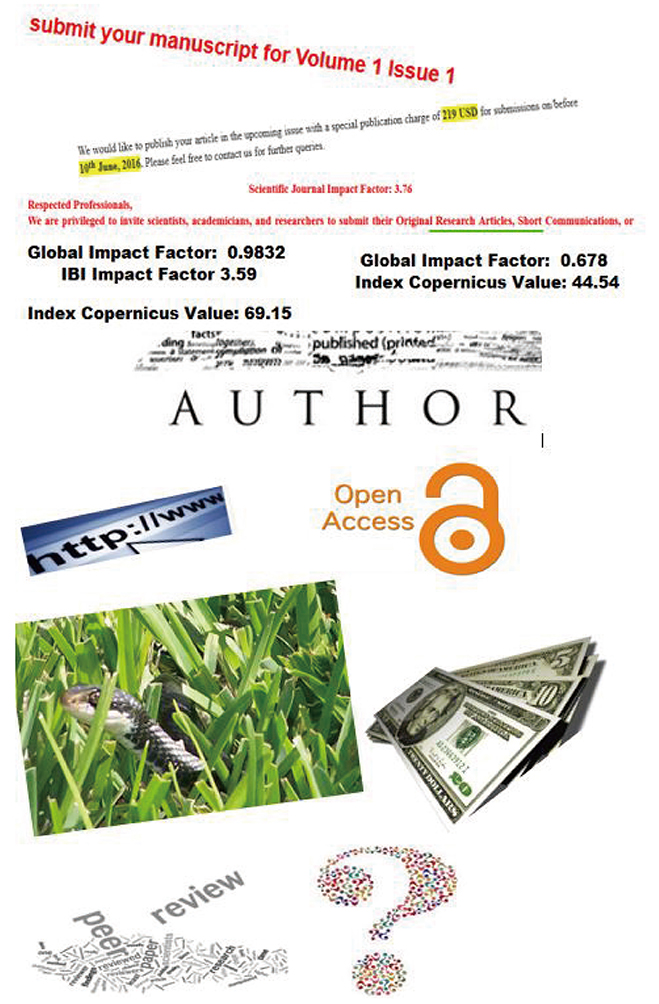J Korean Med Sci.
2017 May;32(5):709-712. 10.3346/jkms.2017.32.5.709.
Manuscript Submission Invitations from ‘Predatory Journals’: What Should Authors Do?
- Affiliations
-
- 1Department of Health Informatics, Institute of Public Health, University of Gondar, Ethiopia. mihiretaabush@gmail.com
- 2Leibniz Institute for Prevention Research and Epidemiology - BIPS GmbH, Bremen, Germany.
- 3Telemedicine and eHealth Department, University of Deggendorf, Deggendorf, Germany.
- 4Policy and Planning Directorate, Federal Ministry of Health, Addis Ababa, Ethiopia.
- KMID: 2375068
- DOI: http://doi.org/10.3346/jkms.2017.32.5.709
Abstract
- Press freedom and worldwide internet access have opened ample opportunity for a staggering number of poor open access journals and junk publishers to emerge. Dubious publishers are abusing and camouflaging the golden open access model. In 2012, Jeffery Beall shed light on the predatory journals (as he preferred to call them) and the threat to open access scientific publication. Publishing in predatory journals is continuing to be a major threat for the development of science in developing countries. The authors of this article proposed solutions and outline a fresh perspective to help authors avoid publishing in predatory journals.
Figure
Cited by 1 articles
-
Improving Scientific Writing Skills and Publishing Capacity by Developing University-Based Editing System and Writing Programs
Edward Barroga, Hiroshi Mitoma
J Korean Med Sci. 2019;34(1):. doi: 10.3346/jkms.2019.34.e9.
Reference
-
1. Walker RL, Sykes L, Hemmelgarn BR, Quan H. Authors' opinions on publication in relation to annual performance assessment. BMC Med Educ. 2010; 10:21.2. Bartholomew RE. Science for sale: the rise of predatory journals. J R Soc Med. 2014; 107:384–385.3. Giglia E. Open access to scientific research: where are we and where are we going? Facts and figures on the occasion of the 2010 Open Access Week (October 18-24). Eur J Phys Rehabil Med. 2010; 46:461–469.4. Samkange-Zeeb F, Zeeb H. Open access under scrutiny. J Radiol Prot. 2013; 33:885–886.5. Beall J. Dangerous predatory publishers threaten medical research. J Korean Med Sci. 2016; 31:1511–1513.6. Natarajan S, Nair AG. “FakeBooks”--predatory journals: the dark side of publishing. Indian J Ophthalmol. 2016; 64:107–108.7. Hansoti B, Langdorf MI, Murphy LS. Discriminating between legitimate and predatory open access journals: report from the International Federation for Emergency Medicine Research Committee. West J Emerg Med. 2016; 17:497–507.8. Beall J. Beall's list of predatory publishers: 2016 [Internet]. 2016. accessed on 3 March 2017. Available at https://jurnsearch.wordpress.com/2016/01/05/bealls-list-of-predatory-publishers-2016/.9. Xia J, Harmon JL, Connolly KG, Donnelly RM, Anderson MR, Howard HA. Who publishes in “predatory” journals? J Assoc Inf Sci Technol. 2015; 66:1406–1417.10. Bohannon J. Who’s afraid of peer review? Science. 2013; 342:60–65.11. Lakhotia SC. Predatory journals and academic pollution. Curr Sci. 2015; 108:1407–1408.12. Shen C, Björk BC. ‘Predatory’ open access: a longitudinal study of article volumes and market characteristics. BMC Med. 2015; 13:230.13. Beall J. Essential information about predatory publishers and journals. Ind High Educ. 2016; 86:2–3.14. Shanta A, Pradhan AS, Sharma SD. Impact factor of a scientific journal: is it a measure of quality of research? J Med Phys. 2013; 38:155–157.15. Gasparyan AY, Nurmashev B, Voronov AA, Gerasimov AN, Koroleva AM, Kitas GD. The pressure to publish more and the scope of predatory publishing activities. J Korean Med Sci. 2016; 31:1874–1878.16. The Biosemantics Group (NL). Journal/author name estimator [Internet]. accessed on 3 March 2017. Available at http://jane.biosemantics.org/.
- Full Text Links
- Actions
-
Cited
- CITED
-
- Close
- Share
- Similar articles
-
- How to write and publish medical papers in English: practical advice from the submission of an original manuscript to the publication of a revised manuscript
- How To Cope With Predatory Journals
- Dangerous Predatory Publishers Threaten Medical Research
- Case of Misconduct of Publication Ethics: Fabrication of of Manuscript Submission Proof
- The Korean Journal of Radiology Launches an Online Manuscript Submission and Tracking System for Peer Review


